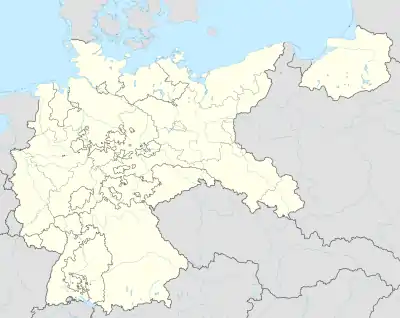Fredy Hirsch
Alfred Hirsch (Hebrew: פרדי הירש) (11 February 1916 – 8 March 1944) was a German Jewish athlete, sports teacher and Zionist youth movement leader, notable for helping thousands of Jewish children during the German occupation of Czechoslovakia in Prague, Theresienstadt concentration camp, and Auschwitz. Hirsch was the deputy supervisor of children at Theresienstadt and the supervisor of the children's block at the Theresienstadt family camp at Auschwitz II-Birkenau.
Fredy Hirsch פרדי הירש | |
|---|---|
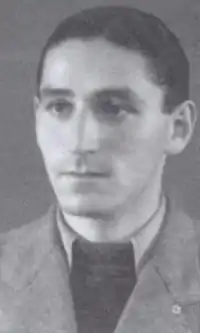 Alfred Hirsch | |
| Born | Alfred Hirsch 11 February 1916 |
| Died | 8 March 1944 (aged 28) |
| Nationality | German Jew |
| Occupation | Athlete, sports teacher, Zionist youth movement activist |
| Organization | Jüdischer Pfadfinderbund Deutschland, Maccabi Hatzair |
| Known for | Helping Jewish children during the Holocaust |
| Partner(s) | Jan Mautner |
Because of his German extraction, charisma, and careful appearance, he was able to convince SS guards to grant privileges to the children, including exemptions from deportation and extra rations, which saved their lives at least temporarily. Hirsch and his assistants maintained clandestine education under the difficult circumstances. Hirsch's insistence on exercise, discipline, and strict hygiene reduced death rates among the children.
The family camp was due to be liquidated on 8 March 1944; Hirsch's popularity made him a natural leader for an uprising. According to some accounts, he committed suicide in order not to have to witness the deaths of his charges; alternately, he was poisoned by Jewish doctors who would have been killed if an uprising had broken out.
Early life
Germany
Hirsch was born in Aachen to Heinrich and Olga Hirsch on 11 February 1916; his father, who ran a butcher shop, died when he was ten years old. According to Fredy's niece, Raquel Masel, his brother, Paul Hirsch (1914–1979), was not close to their mother because of her bitterness. Their poor relationship encouraged Fredy and Paul to join youth organizations.[1][2][3] Both brothers attended the Aachener Couven-Gymnasium, which was not a Jewish school.[4] Fredy left in March 1931 when his mother moved, but there is no evidence that he attended another school, and apparently he continued to live in Aachen.[5] The Jewish community of Aachen was well-integrated; there was little antisemitism in Aachen before the Nazi Party came to power in 1933. Hirsch was already giving lectures at the age of 15.[1][3]
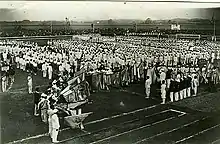
Hirsch took over the leadership of the scouting branch of the local Aachen Jewish youth association in 1931, and participated in founding the Aachen branch of the Jüdischer Pfadfinderbund Deutschland (Jewish Scouting Association of Germany, JPD), a German Jewish scouting organization, in 1932. Later that year, Hirsch moved to Düsseldorf for a job with the JPD. The JPD had Zionist tendencies and a close affiliation with Maccabi Hatzair, a Zionist sporting association. Although Paul joined the JPD, he, like many in the Aachen Jewish community, believed in assimilating into the non-Jewish community. Fredy became an ardent Zionist, supporting the establishment of a Jewish state in Palestine.[1][2]
Under the background of rising, state-sponsored antisemitism, the JPD training became increasingly militarized, emphasizing drills, marching with heavy loads, and first-aid training.[5] In 1933, the JPD merged into Maccabi Hatzair. Hirsch moved to Frankfurt, where he shared a flat with leading JPD officials and led a scouting group. His time in Frankfurt was cut short by rumors that he was gay, based on his lack of a girlfriend and behavior towards some of the boys under his supervision, although he was not accused of inappropriate behavior or misconduct. He moved to Dresden in 1934, where he worked as a sports instructor for Maccabi Hatzair[1] and probably attended lectures at the German College of Physical Education in Berlin.[lower-alpha 1]
Czechoslovakia
After the passage of the Nuremberg Laws in 1935, Hirsch moved to Prague, Czechoslovakia, probably illegally.[lower-alpha 2] According to German historian Dirk Kämper, the author of the first biography of Hirsch, he may have also been motivated to escape the increasing persecution of gay men in Germany.[1][lower-alpha 3] He continued to work for Maccabi Hatzair. The Czech branch of the organization was initially concerned about his reputation, but Hirsch was able to persuade Arthur Herzog, chairman of Maccabi Hatzair in the Czech lands, that his homosexuality did not affect his work.[10]
Between October 1936 and April 1939,[7] Hirsch lived in Brno with his lover Jan Mautner, four years his senior and a medical student from Olomouc. Their relationship was well known in the city, according to Holocaust survivor Ruth Kopečková. Mautner and Hirsch published the Maccabi newspaper, Mautner translating Hirsch's articles into the Czech language, which Hirsch never mastered.[9] Funded by the Zionist World Federation, Hirsch organized local Maccabi Games and set up youth and adult groups for physical education. He organized the 1937 Maccabi Games for Czechoslovakia held in Žilina, Slovakia, with 1,600 participants.[11] Until 1940, Hirsch organized an annual youth camp at Bezpráví, where children and teenagers exercised and learned Hebrew.[12] Paul, a Reform rabbinical student, emigrated with their mother and her second husband to Bolivia in 1938; Paul eventually became a rabbi in Buenos Aires.[1][13] Fredy could have accompanied them, but did not; Paul later said that Fredy's Zionist convictions had prevented him.[1][14][15]
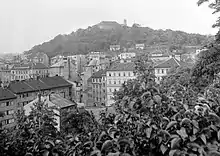
After Brno refused him a residence permit and threatened to expel him, Hirsch returned to Prague.[7] Working at the Zionist Youth Aliyah School run by Egon Redlich, he organized hakhshara (preparation farms) for young Jews seeking to immigrate to Israel and live on a kibbutz, training youth in horticulture, agriculture, and basic military training.[16] In late 1938, the Munich Agreement ceded the Sudetenland (German-speaking region of Czechoslovakia) to Germany; on 15 March 1939, Germany invaded Czechoslovakia, creating the Protectorate of Bohemia and Moravia. Assimilation of the Czech Jews was so high that many children were not even aware that they were Jews.[17] Eighteen boys trained by Hirsch were able to escape to Denmark in October 1939, and immigrated to Palestine the following year. He drew lots with another Zionist youth leader as to which of them would go to Palestine with the boys; Hirsch lost and remained in Prague.[14][1] In 1940, he was joined by Mautner, who was prevented from continuing his studies by the closure of the Czech universities.[9] The same year, Hirsch published an article in the Prague Jewish Newspaper laying out his views on Jewish youth education; Hirsch viewed physical education as essential to promoting well-being and a Zionist consciousness.[11]
Over time, the Germans applied more and more restrictions to Czech Jews; they were fired from their jobs, forced to move, property confiscated, forbidden from certain shops and streets, and eventually forced to wear the Star of David.[18] After the Nazis banned Jews from public spaces, Hirsch organized a playground at Hagibor, in the Strašnice district of Prague, for Jewish children to exercise. Hirsch and Mautner held soccer matches, athletic competitions, study groups, and theatrical performances there.[9][14][19] Although there were other carers, Hirsch's charisma made him the natural leader. Since he could not speak Czech well, he gave instructions in Hebrew and taught the children to speak that language. Survivors reported that Czech songs were written about him.[20] In late 1941, the Nazis began deporting Czech Jews, first to the Łódź Ghetto. Hirsch helped prepare the deportees with the 50 kilograms (110 lb) of luggage they were allowed to bring.[21]
The Holocaust
Theresienstadt
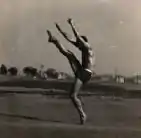
Hirsch was one of the first Jews to be transported to Theresienstadt concentration camp on 4 December 1941, where he helped to construct the concentration camp. His friendship with Jakob Edelstein lead to an appointment with the housing department.[22] Later, Hirsch became the deputy to Egon Redlich, the leader of the Youth Services Department;[lower-alpha 4][19] Redlich personally disliked Hirsch,[lower-alpha 5] but respected his competence and leadership ability.[1][24] Mautner was also deported to Theresienstadt in early 1942.[9] At Theresienstadt, the children lived separately from the adults. Based on the teachings of Zionist youth movements,[25] Hirsch insisted on maintaining self-esteem, discipline, regular exercise[26] and strict hygiene—even holding cleanliness competitions[27]—in order to maximize their chances of survival.[14] The youth leaders tried to maintain the children's education despite this being prohibited, teaching a wide range of subjects including Hebrew, English, mathematics, history, and geography.[28][19] However, the Germans did not actively oppose his activities because they felt that it helped maintain order.[26] Children 14 and older had to work; Hirsch tried to get them jobs working in the vegetable gardens because he believed that this work would improve their health and prepare them for life in Palestine.[29]
Survivors often remarked on Hirsch's self-confident attitude, good looks, and careful appearance, which had a salutary effect on other prisoners.[30][26] He paid attention to his posture and appearance, keeping his hair combed and boots polished,[14][25] and reportedly continuing to pomade his hair at Auschwitz.[31] Hirsch was able to establish a good relationship with SS guards even though he was Jewish and openly gay.[lower-alpha 6][32][2] According to Yehuda Bacon, "he spoke German as well as the Nazis, he had charm and a tip-top look. He knew how to talk to the SS. He was dressed like a soldier."[14] Pavel Stránský, who had been an educator on the children's block at Auschwitz, testified that "[t]he SS treated him almost like a human being".[lower-alpha 7]
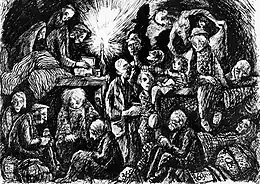
Redlich and Hirsch used their influence to arrange separate barracks and slightly better conditions for the children.[33] Sometimes they were able to remove children from transports to extermination camps, although they were ultimately unable to save them from this fate; more than 99% of the children at Theresienstadt were eventually deported.[30] Hirsch persuaded the Germans to allocate space for a play area inside the concentration camp, where he frequently oversaw athletic activities.[26][34] In 1943, Maccabi Games were held and observed by thousands of spectators.[14][19]
On 24 August 1943, a single transport of 1,200 children from the Białystok Ghetto arrived at Theresienstadt.[35] These children were frightened of the showers because they believed that they were gas chambers. The Białystok children were housed in the western barracks, separated from the rest of the camp by a barbed-wire fence. Czech gendarmes guarded the perimeter and kept the children strictly segregated from the rest of the camp under threat of severe punishment.[36][37] According to Kämper, Hirsch wanted to confirm the rumors that Jews deported from Theresienstadt were murdered in gas chambers. In any event, he managed to jump over the wire fence separating the Białystok children from the rest of the Theresienstadt prisoners, but he was caught and arrested by a Czech guard. Peter Erben believes that Hirsch could have avoided punishment if he had been able to speak Czech. Instead, he was brought to the commandant's office and beaten.[38] Allegedly for this violation, he was deported to Auschwitz on 8 September.[14][19]
Auschwitz

The Jews from Theresienstadt encountered unprecedented privileged treatment upon their arrival, where they were established in a separate block (BIIb), known as the Theresienstadt family camp. They were tattooed, but were not subject to selection upon arrival, were allowed to retain their civilian clothes, and were not forced to shave their heads. Families stayed together and were also allowed to write to their relatives at Theresienstadt, to those not yet deported, and even to friends in neutral countries, in order to convey the impression that deportation to the east did not necessarily mean death.[39][40][41]
Hirsch was appointed the lagerälteste of the family camp, because of the respect that the SS had for his leadership. He refused to use violence against other prisoners, as the Germans demanded. As a result, he was relieved of his position a month later and replaced by the German criminal Arno Böhm.[42] However, he persuaded Böhm to allocate a barracks, Block 31, for children younger than fourteen, and became the overseer of this barracks.[43][44] In this arrangement, the children lived with their parents at night and spent the day at the special barracks. Hirsch recruited adult prisoners who had been involved in education at Theresienstadt and persuaded the guards that it would be in their interest to have the children learn German. In fact, the teachers taught other subjects, including history, music, and Judaism, in Czech, as well as a few German phrases to recite at inspections. Because there were only twelve books and almost no supplies, the teachers had to recite lessons from memory.[25][44] The children's lack of education[45]—they had been excluded from school even before their deportation[46]—made their task more difficult.[45] A chorus rehearsed regularly, a children's opera was performed, and the walls of the barracks were painted with Disney characters by Dina Gottliebová.[47][48][49] Because the block was so orderly, it was shown off to SS men who worked in other parts of the camp.[45] SS men who directly participated in the extermination process, especially Dr. Josef Mengele, visited frequently and helped organize better food for the children.[48][50]
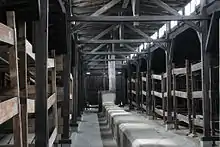
Using his influence with the Germans, Hirsch obtained better food for the children and food parcels addressed to prisoners who had died.[19][51] The soup for the children was thicker than for other prisoners; allegedly it was from the Gypsy camp and contained semolina.[52] The children's barracks also received additional coal and was slightly better heated.[53] Hirsch also convinced the Germans to hold roll call inside the barracks, so the children were spared the hours-long ordeal of standing outside in all weather.[54] After another transport arrived in December 1943, there were about 700 children in the family camp;[49] Mautner was also on this transport.[9][lower-alpha 8] Zuzana Růžičková, who had also arrived in December, entered into the children's barracks without authorization in order to obtain work as a carer, but was caught by an SS man. To distract him, Hirsch reportedly said "Herr Oberscharführer, who have you killed and looted today?"[lower-alpha 9] Instead of beating Hirsch, the SS man offered him a cigarette, which Hirsch declined.[55] Nevertheless, Hirsch was not excepted from the brutal treatment of the guards, being badly beaten when a boy slept through the roll call.[56]
Hirsch persuaded Böhm to allocate a second barracks for children aged three to eight so that the older children could prepare a performance of Snow White, which the SS had requested.[57] The play was performed on 23 January 1944 with many SS men in attendance.[58] By imposing strict discipline on the children, Hirsch made sure that there were no acts of violence or theft, otherwise common in concentration camps.[51] He was extremely strict about the children's hygiene, insisting that they wash daily even in the frigid winter of 1943–44 and carrying out regular inspections for lice.[54][52] Due to Hirsch's efforts, the mortality rate for the children was nearly zero, compared to the overall mortality of about 25% of the residents of the family camp in the first six months.[14][59] The children appreciated Hirsch's efforts on their behalf, and threw a surprise party for him on 11 February 1944, his 28th birthday.[60][31] In February 1944, a delegation from the Reich Main Security Office and the German Red Cross visited the family camp. The visitors were most interested in the children's barracks, which was the only attempt to organize education at Auschwitz. The most notable visitor, Adolf Eichmann, commented favorably about the cultural activity of the children at Birkenau.[61][62]
Death
Arrivals to the family camp were marked "SB6"[63]—a cryptic abbreviation that the Auschwitz resistance movement eventually decoded as referring to Sonderbehandlung ("special treatment"). This meant that the arrivals were to be murdered 6 months after their arrival, or 8 March 1944 for the transport that Hirsch was on. Hirsch and other leaders from Theresienstadt were informed in advance by the resistance movement at Auschwitz. By this time, it was evident to the prisoners that the Germans were going to lose the war and some hoped for a swift Allied victory before their six months had elapsed.[64][57] Although there was no possibility of success, many Jews wanted to set the compound on fire as a symbolic act of resistance. Hirsch was the natural leader for an uprising, because he was respected by opposing factions in the family camp.[57] On 5 March, the September arrivals were told that they were soon to be transported to a labor camp at Heydebreck and instructed to write postcards dated 25 March for their relatives in Theresienstadt.[61] On 7 March, they were moved to the quarantine block (BIIa);[65] although warned in advance that the Nazis were planning to murder all of these Jews, Hirsch went with them.[66]

What happened after this is unclear.[67] Rudolf Vrba, the clerk of BIIa,[68] visited Hirsch on 8 March to inform him about the preparations for the liquidation of the family camp and to urge him to lead an uprising. Apparently Hirsch was uncertain whether to believe the warnings about imminent death and skeptical of the value of resistance. He thought it was unreasonable that the Nazis would give them such favored treatment only to murder them later.[69][19] Hirsch asked for an hour to think, and when Vrba returned, Hirsch was in a coma. A Jewish doctor told Vrba that Hirsch had committed suicide by a barbiturate overdose. If he did commit suicide, it is unclear how he could have obtained a lethal dose without the cooperation of the doctors.[19]
According to some survivors,[lower-alpha 10] Hirsch requested a small dose of a tranquilizer to help him calm down, but the Jewish doctors poisoned him to prevent him from leading an uprising, which they feared would compromise their own chances of survival. Mengele had promised them that they would not be killed.[14][72] The latter explanation is favored by Kämper.[73] A few people, including doctors and the artist Dina Gottliebová, were spared from death by their special talents which were useful to the SS. According to survivor testimonies, Hirsch was to be spared, but he was unwilling to save himself without the children.[72][74] On the night of 8 March, a strict curfew was imposed and the Jews in the quarantine blocks were loaded in trucks and driven to the gas chambers.[72][75] Still unconscious, Hirsch was carried with them and died along with many of the children under his supervision.[19]
Legacy
According to postwar testimonies, Hirsch was "a man of extraordinary courage" and "for the children a God",[30] although some of his adult colleagues dismissed him as arrogant, shallow, dictatorial, or vain.[31][76] The gymnasium in Aachen that he attended renamed its cafeteria the "Fredy-Hirsch-AG" in 2016.[4] At a commemoration ceremony in the Aachen synagogue on the one hundredth anniversary of Hirsch's birth, Lord Mayor Marcel Philipp stated that Hirsch was "one of the most important sons of the city, if not the best known".[lower-alpha 11] Nina Weilová, who survived the Theresienstadt family camp as a young teenager, said that "There was no one who was so self-sacrificing and devoted himself to the children as much as he did."[76] Czech Jewish harpsichordist Zuzana Růžičková worked as a teacher's assistant at the children's barracks at Auschwitz and credited Hirsch for saving her life. Many years later, she helped organize a monument for him. At the dedication, she said, "We Jews have no saints, but we have 'tzadikim'—the word could be translated as 'righteous' or 'decent'. Fredy Hirsch was a man, he had his faults, he was not a saint, but he was righteous—a tzadik—and so we hope that when the last of us who knew him have passed away, future generations will stand before this tablet and say: 'He must have been a good, brave and beautiful person'."[lower-alpha 12]
.JPG.webp)
Hirsch was the subject of the 2016 documentary Heaven in Auschwitz, which featured the accounts of thirteen survivors of Theresienstadt and Auschwitz.[8][80] He was also featured in the 2017 Israeli documentary "Dear Fredy" by Rubi Gat.[14][8]
According to Dirk Kämper, Hirsch's role was marginalized after the war because of his homosexuality.[2] In communist Czechoslovakia, his German ethnicity and Zionism made him an unacceptable hero.[81] Historian Anna Hájková, investigating the relationship between Hirsch and Mautner, writes that theirs was "one of the rare queer life stories that can be reconstructed for the Nazi era".[lower-alpha 13] Hirsch is the rare exception to the absent or anonymous gay Holocaust victim because he worked with children and teenagers, who lived long enough to tell the truth about him.[8] She also noted the lingering homophobia in the Terezín Initiative, the Czech association of Holocaust survivors, which refused to print an inquiry from her regarding their relationship. According to Hájková, "It is disturbing that even in 2018 the homosexuality of a Holocaust victim is considered to be offensive".[lower-alpha 14]
References
Notes
- Witnesses claimed that Hirsch attended the German College of Physical Education in Berlin. Dirk Kämper found no evidence that Hirsch had ever been enrolled there, but stated that he probably attended lectures.[6]
- When Hirsch moved to Brno in 1936, the authorities noted that he could not prove that he had permission to live or work in Czechoslovakia.[7]
- Homosexual behavior was also criminalized in Czechoslovakia, but there was a movement for repeal.[8][9]
- Also known as the Youth Welfare Office[23]
- Known to hold homophobic attitudes, Redlich fired a young woman from a teaching position at Theresienstadt when he found out that she was in a lesbian relationship.[8]
- "Indeed, it was well known in Prague that Hirsch was gay. Nor did he hide it at Theresienstadt – Terezín in Czech – or Auschwitz. 'We’d heard that Fredy was gay,' [Dita] Kraus (es) told me in an interview, 'but we didn’t care about that at all. It wasn’t an issue anywhere.'"[14] Zuzana Růžičková later described being helped by Hirsch after her arrival at Theresienstadt; she heard that he was gay and asked her parents about it. They told her that it only mattered whether he was a good person or not.[1] Due to homophobic attitudes common at the time, male adolescents were warned not to be alone with him.[8]
- German: Die SS behandelte ihn fast wie ein menschliches Wesen Heinz Moll in l in Beilage Literatur, Prager Zeitung, 10 May 2001, p. 10. Quoted in Hartung-Gorre Verlag (2008)
- During the second liquidation of the family camp in July 1944, Mautner was selected for labor. He survived Auschwitz, Sachsenhausen, and a death march back to Theresienstadt. However, he contracted tuberculosis in the camps and died in 1951; his partner, Walter Löwy, whom Mautner met after the war, later emigrated to Munich.[9]
- German: ja also Herr Oberscharführer, wo haben Sie denn heute wieder getötet und geplündert?[55]
- Including Ruth Bondy,[70] Ota Kraus,[14] and Dita Kraus[71]
- German: ein bedeutender Sohn der Stadt, wenn auch nicht der bekannteste.[77]
- German: Wir Juden haben keine Heiligen. Wir haben jedoch die ' Zaddikim ' - Gerechte - oder könnte man vielleicht übersetzen - Anständige? Fredy Hirsch war ein Mensch, er hatte seine Fehler, er war kein Heiliger. Er war jedoch ein Gerechter - ein Zaddik . Und so wollen wir hoffen, dass, wenn der Letzte von uns, die wir ihn kannten, dahingegangen ist, künftige Generationen vor dieser Tafel stehen bleiben und sagen: Dies muss ein guter, tapferer und schöner Mensch gewesen sein.[78]
- German: eine der seltenen queeren Lebensgeschichten, die sich für die NS-Zeit rekonstruieren lassen.[9]
- German: Ein verstörender Beleg, dass selbst im Jahr 2018 die Homosexualität eines Holocaustopfers als ehrenrührig gilt.[9]
Citations
- Nendza & Hoffman 2017a.
- Neugroeschel 2016.
- Nendza & Hoffman 2017b, p. 2.
- Gasper 2016.
- Nendza & Hoffman 2017b, p. 3.
- Nendza & Hoffman 2017b, pp. 5–6.
- Nendza & Hoffman 2017b, p. 9.
- Hájková 2018a.
- Hájková 2018b.
- Nendza & Hoffman 2017b, p. 6.
- Nendza & Hoffman 2017b, p. 7.
- Nendza & Hoffman 2017b, p. 8.
- Gedenkbuchprojekt 2008.
- Aharony 2018.
- Nendza & Hoffman 2017b, p. 4.
- Nendza & Hoffman 2017b, p. 13.
- Nendza & Hoffman 2017b, p. 10.
- Nendza & Hoffman 2017b, p. 11.
- Stránský 2016.
- Nendza & Hoffman 2017b, p. 12.
- Nendza & Hoffman 2017b, p. 15.
- Nendza & Hoffman 2017b, p. 19.
- Adler 2017, p. 487.
- Nendza & Hoffman 2017b, p. 20.
- Bondy 2002, p. 4.
- Gilbert 1999, p. 101.
- Redlich 2015, p. 11.
- Nendza & Hoffman 2017b, p. 21.
- Nendza & Hoffman 2017b, p. 22.
- Redlich 2015, p. 4.
- Nendza & Hoffman 2017b, p. 32.
- Bondy 2002, p. 5.
- Křížková, Koutouč & Ornest 1995, p. 30.
- Křížková, Koutouč & Ornest 1995, p. 52.
- Klibanski 1995, p. 93.
- Adler 2017, p. 126.
- Klibanski 1995, p. 94.
- Nendza & Hoffman 2017b, p. 23.
- Kulka 1965, p. 199.
- Bondy 2002, pp. 1–2.
- Adler 2017, p. 48.
- Nendza & Hoffman 2017b, p. 28.
- Bondy 2002, pp. 4–5.
- Jahn 2007, p. 114.
- Langbein 2005, p. 245.
- Bondy 2002, p. 9.
- Nendza & Hoffman 2017b, p. 31.
- Paldiel 2017, p. 388.
- Jahn 2007, p. 115.
- Langbein 2005, p. 353.
- Bondy 2002, p. 8.
- Nendza & Hoffman 2017b, p. 29.
- Nendza & Hoffman 2017b, p. 30.
- Bondy 2002, p. 6.
- Nendza & Hoffman 2017b, p. 33.
- Nendza & Hoffman 2017b, p. 34.
- Langbein 2005, p. 246.
- Bondy 2002, p. 10.
- Bondy 2002, pp. 2, 8.
- Bondy 2002, p. 11.
- Kulka 1965, p. 188.
- Czech 1990, p. 591.
- Paldiel 2017, p. 386.
- Bondy 2002, pp. 2–3.
- Lasik 2000, p. 228.
- Křížková, Koutouč & Ornest 1995, p. 53.
- Bondy 2002, pp. 12–13.
- Braham 2002, p. 80.
- Nendza & Hoffman 2017b, p. 36.
- Kárný 1999, p. 31.
- Radio Wave 2013.
- Bondy 2002, p. 13.
- Nendza & Hoffman 2017b, p. 37.
- Langbein 2005, p. 247.
- Nendza & Hoffman 2017b, p. 38.
- Langbein 2005, p. 244.
- Stresius 2016.
- Hartung-Gorre Verlag 2008.
- Stolperstein 2008.
- Jewish International Film Festival 2016.
- Nendza & Hoffman 2017b, p. 41.
Print sources
- Adler, H. G. (2017). Theresienstadt 1941–1945: The Face of a Coerced Community. Cambridge University Press. ISBN 9780521881463.
- Bondy, Ruth (2002). "משחקים בצל המשרפות מעון הילדים במחנה המשפחות בבירקנאו (ספטמבר 1943 יולי (1944" [Games in the shadow of the crematoria: the children's barracks in the Birkenau family camp (September 1943 – 1944)]. שורשים עקורים: פרקים בתולדות יהדות צ'כיה, 1945-1939 [Displaced Roots: Chapters in the History of Czech Jewry, 1939–1945] (in Hebrew). Jerusalem: Yad Vashem. pp. 137–158. ISBN 9789653081512. From an online version paginated 1–16.
- Braham, Randolph L. (2002). The Nazis' Last Victims: The Holocaust in Hungary. Wayne State University Press. ISBN 978-0-8143-3883-4.
- Czech, Danuta (1990). Auschwitz Chronicle, 1939-1945. New York: Henry Holt and Company. ISBN 9780805052381.
- Gilbert, Martin (1999). Holocaust Journey: Traveling in Search of the Past. Columbia University Press. ISBN 978-0-231-10965-9.
- Jahn, Franziska (2007). ""Theresienstädter Familienlager" (BIIb) in Birkenau". In Benz, Wolfgang; Distel, Barbara (eds.). Der Ort des Terrors (in German). 5. Munich: C.H.Beck. pp. 112–115. ISBN 978-3-406-52965-8.
- Kárný, Miroslav (1999). Translated by Liebl, Petr. "Fragen zum 8. März 1944" [Questions about 8 March 1944]. Theresienstädter Studien und Dokumente (in German) (6): 9–42.
- Klibanski, Bronka (1995). "Kinder aus dem Ghetto Bialystok in Theresienstadt" [Children from the Białystok Ghetto in Theresienstadt]. Theresienstädter Studien und Dokumente (in German) (2): 93–106.
- Křížková, Marie Rút; Koutouč, Kurt Jiří; Ornest, Zdeněk (1995). We are children just the same: Vedem, the secret magazine by the boys of Terezín. Jewish Publication Society.
- Kulka, Erich (1965). "Terezín, a Mask for Auschwitz". In Ehrmann, František; Heitlinger, Ota; Iltis, Rudolf (eds.). Terezín. Prague: Council of Jewish Communities in the Czech Lands. pp. 182–203. OCLC 12720535.
- Langbein, Hermann (2005). People in Auschwitz. Univ of North Carolina Press. ISBN 978-0-8078-6363-3.
- Lasik, Aleksander (2000). Auschwitz 1940–1945: central issues in the history of the camp. The establishment and organization of the camp. Auschwitz-Birkenau State Museum. ISBN 9788385047872.
- Paldiel, Mordecai (2017). Saving One's Own: Jewish Rescuers During the Holocaust. Lincoln: University of Nebraska Press. ISBN 9780827612976.
- Redlich, Gonda (2015). Friedman, Saul S. (ed.). The Terezin Diary of Gonda Redlich. University Press of Kentucky. ISBN 978-0-8131-5012-3.
Web sources
- Aharony, Michal (5 April 2018). "The unknown hero who saved children at Auschwitz". Haaretz. Retrieved 2 August 2018.
- Gasper, Margot (8 February 2016). "Wer war Fredy Hirsch? Eine Spurensuche" [Who was Fredy Hirsch? A search for traces]. Aachener Nachrichten. Retrieved 5 September 2018.
- "Gedenkbuchprojekt: Biographie Fredy Hirsch" (in German). 2008. Retrieved 5 September 2018.
- Hájková, Anna (18 February 2018). "Why We've Suppressed the Queer History of the Holocaust". Haaretz. Retrieved 22 September 2018.
- Hájková, Anna (2 May 2019). "Fredy Hirsch's Lover: Could a homosexual love survive Theresienstadt?". Tablet.
- Hájková, Anna (31 August 2018). "Die Geschichte von Jan Mautner und Fredy Hirsch: Jung, schwul – und von den Nazis ermordet" [The story of Jan Mautner and Fredy Hirsch: Young, gay - and murdered by the Nazis]. Der Tagesspiegel Online (in German). Retrieved 5 September 2018.
- "Lucie Ondřichová: Fredy Hirsch" (in German). Hartung-Gorre Verlag. Retrieved 5 September 2018.
- "Heaven in Auschwitz". Jewish International Film Festival (JIFF) Australia and New Zealand. 2016. Archived from the original on 28 September 2017. Retrieved 27 September 2017.
- Nendza, Jürgen; Hoffmann, Eduard (28 January 2017). "Eine Lange Nacht über Fredy Hirsch: Der stille Held von Auschwitz" [A Long Night over Fredy Hirsch: The unsung hero of Auschwitz]. Deutschlandfunk (in German). Retrieved 5 September 2018.
- Nendza, Jürgen; Hoffmann, Eduard (28 January 2017). "Eine Lange Nacht über Fredy Hirsch: Der stille Held von Auschwitz" [A Long Night over Fredy Hirsch: The unsung hero of Auschwitz] (PDF) (in German).
- Neugroeschel, Marc (14 February 2016). "Educator who saved Holocaust youth commemorated in his native Aachen". The Jerusalem Post. Retrieved 3 August 2018.
- "Knihovnice z Osvětimi: Věřila jsem, že přežiju". Radio Wave (in Czech). 10 October 2013. Retrieved 13 September 2018.
- "Hirsch, Alfred (Fredy)". Wege gegen das Vergessen (in German). 2008. Retrieved 14 September 2018.
- Stránský, Matěj (10 February 2016). "Alfred (Fredy) Hirsch". Terezín Initiative. Retrieved 14 September 2018.
- Stresius, Lothar (12 February 2016). "Fredy Hirsch ist "ein Vorbild für heute"" [Fredy Hirsch is "a role model for today"]. Aachener Nachrichten (in German). Retrieved 5 September 2018.
Further reading
- Becker, Jody. Finding Fredy Hirsch. pp. 1–19.
- Kämper, Dirk (2015). Fredy Hirsch und die Kinder des Holocaust [Fredy Hirsch and the Children of the Holocaust] (in German). Orell Füssli. ISBN 978-3-280-05588-5.
- Ondřichová, Lucie (2001). Příběh Fredyho Hirsche [The Story of Fredy Hirsch] (in Czech). Institut Terezínské iniciativy v nakl. Federace židovských obcí Sefer. ISBN 9788085924329.
- Ondřichová, Lucie (2017). Fredy Hirsch: von Aachen über Düsseldorf und Frankfurt am Main in Prag, Ostrava, Brünn, Prag und andernorts, dann durch Theresienstadt nach Auschwitz-Birkenau : eine jüdische Biographie 1916–1944 [Fredy Hirsch: from Aachen via Düsseldorf and Frankfurt am Main in Prague, Ostrava, Brno, Prague and elsewhere, then through Theresienstadt to Auschwitz-Birkenau: a Jewish biography 1916–1944] (in German). Translated by Prackatzsch, Astrid. Hartung-Gorre Verlag. ISBN 978-3-86628-586-6.
External links
- Trailer for Heaven in Auschwitz on YouTube
- Opening scene of Dear Fredy on YouTube
- Primary source material on Hirsch in the collections of the Jewish Museum in Prague
